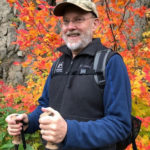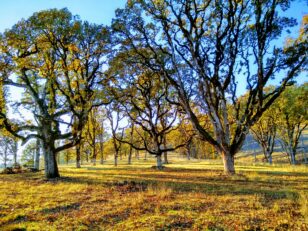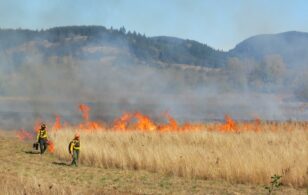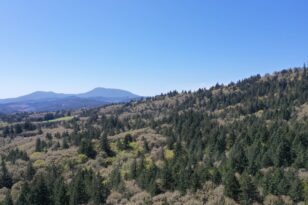* This post has been adapted from “Toward a political ecology of ecosystem restoration” by John C. Bliss and A. Paige Fischer, Chapter 10 in Human Dimensions of Ecological Restoration; Integrating Science, Nature, and Culture, edited by Dave Egan, Evan E. Hjerpe, and Jesse Abrams.
 The lone Oregon White Oak (Quercus garyyana) standing majestically above a hillside of prairie grass and flowers, is an icon of the Willamette Valley, and of the Greenbelt Land Trust. For many of us, a landscape of dark green oaks punctuating an open savannah just feels like home.
The lone Oregon White Oak (Quercus garyyana) standing majestically above a hillside of prairie grass and flowers, is an icon of the Willamette Valley, and of the Greenbelt Land Trust. For many of us, a landscape of dark green oaks punctuating an open savannah just feels like home.
Our personal attachment to the oak savanna landscape is not unique; ever since our species’ emergence on the grassy plains of Africa, Homo sapiens has demonstrated a special affinity for mixed, open-canopy woodland and savanna landscapes. With their abundance and diversity of game and edible plants, fuel for cooking and warmth, protection from weather and wide-open views of predators, these landscapes provided everything hunter-gatherers needed. Over the millennia that humans co-evolved with these systems, the landscape imprinted on us, compelling us to seek stands of widely spaced trees over prairie grasses in which to live. In turn, we imprinted our will on the landscape through pervasive, deliberate, and sophisticated management to fulfill human needs.
Oregon’s Willamette Valley is bordered by isolated remnants of the oak savanna and woodlands that once dominated the entire basin from the lower slopes of the Coast Range on the west to the Cascade Mountains on the east. These ecosystems, appealing to the human eye and rich in biodiversity, are among the state’s most endangered, covering only a few percent of the area they occupied at the time of Euro-American settlement in the mid-1800s. Their story illustrates the complex interplay between ecological dynamics and evolving human values, preferences, needs and constraints.
The history of oak savanna corresponds to the history of human presence in the Pacific Northwest; both date back more than 6,000 years to the end of the most recent dry period in North American climate (Stein 1990). It appears the habitat assumed a range of ecosystem functions and disturbance patterns throughout its history (McShea and Healy 2002). For example, tree core data from several sites in the Pacific Northwest indicate Willamette Valley oaks burned frequently by low intensity fires, but only between the mid-1700s and 1900 (Agee 1993). This lack of consistency suggests that oak may have conformed more to variations in human activity than to other ecological processes.
 Kalapuya and other local Native American groups were some of the first people to shape Willamette Valley ecosystems to meet their needs. Prior to European settlement they used fire as a management tool to maintain gardens of camas (Camassia spp.), a native prairie plant whose starchy bulb was a food staple, and foster the growth of tarweed, grasshoppers, nut and berry plants, and bracken fern rhizomes (Agee 1993, Boyd 1999). They also set fires to herd deer for hunting. Oregon white oak (Quercus garryana) is adapted to fire in ways that other species, such as Douglas-fir (Pseudotsuga menzeissi), are not. Their thick bark protects the delicate cambium and dormant buds are located low on the root collar below the soil surface so they can sprout even after fire (Tveten and Fonda 1999). The fires the Kalapuya set thinned the understory of the oak woodlands and savannas, maintaining the stands’ open structure, enhancing tree vigor and seedling regeneration and increasing mast crops for consumption by both humans and game (Agee 1993, Agee 1995, Boyd 1999, Peter and Harrington 2002, Van Lear and Brose 2002). The fires also limited infestations by invasive plants and acorn boring insects (Anderson 2005). The fires promoted the local oak species over other tree species. The net effect of Kalapuyan management was to create an overstory of widely-spaced, large-crowned Oregon white oak trees with an understory of shrubs and perennial native grasses (Agee 1990).
Kalapuya and other local Native American groups were some of the first people to shape Willamette Valley ecosystems to meet their needs. Prior to European settlement they used fire as a management tool to maintain gardens of camas (Camassia spp.), a native prairie plant whose starchy bulb was a food staple, and foster the growth of tarweed, grasshoppers, nut and berry plants, and bracken fern rhizomes (Agee 1993, Boyd 1999). They also set fires to herd deer for hunting. Oregon white oak (Quercus garryana) is adapted to fire in ways that other species, such as Douglas-fir (Pseudotsuga menzeissi), are not. Their thick bark protects the delicate cambium and dormant buds are located low on the root collar below the soil surface so they can sprout even after fire (Tveten and Fonda 1999). The fires the Kalapuya set thinned the understory of the oak woodlands and savannas, maintaining the stands’ open structure, enhancing tree vigor and seedling regeneration and increasing mast crops for consumption by both humans and game (Agee 1993, Agee 1995, Boyd 1999, Peter and Harrington 2002, Van Lear and Brose 2002). The fires also limited infestations by invasive plants and acorn boring insects (Anderson 2005). The fires promoted the local oak species over other tree species. The net effect of Kalapuyan management was to create an overstory of widely-spaced, large-crowned Oregon white oak trees with an understory of shrubs and perennial native grasses (Agee 1990).
 Euro-American pioneers in the Willamette Valley also burned the land (Boyd 1999). Yet these settlers who displaced the Native Americans also brought with them a set of values, preferences, needs and constraints that stood in stark contrast to those of their predecessors. Where Kalapuyans saw prime camas grounds, settlers saw potential pastures and crop fields. In open oak woodlands they saw cabin logs, lumber, and well-drained agricultural fields. And in wildfire they saw a threat to their homes and settlements. As a result, camas fields were ditched and drained, wooded savannas were cleared and plowed, and, in the absence of fires, oak stands developed thick understories and shade-tolerant species, such as Douglas-fir, encroached on and outcompeted oak in the canopy.
Euro-American pioneers in the Willamette Valley also burned the land (Boyd 1999). Yet these settlers who displaced the Native Americans also brought with them a set of values, preferences, needs and constraints that stood in stark contrast to those of their predecessors. Where Kalapuyans saw prime camas grounds, settlers saw potential pastures and crop fields. In open oak woodlands they saw cabin logs, lumber, and well-drained agricultural fields. And in wildfire they saw a threat to their homes and settlements. As a result, camas fields were ditched and drained, wooded savannas were cleared and plowed, and, in the absence of fires, oak stands developed thick understories and shade-tolerant species, such as Douglas-fir, encroached on and outcompeted oak in the canopy.
As the region became the nation’s timber basket during the twentieth century landowners cultivated and encouraged Douglas-fir anywhere it would grow, converting oak-canopied pastures, fields, and woodlands to timber plantations. Farmers shifting to more lucrative crops, such as rye grass, also removed savanna oaks that cast shade onto their fields on the valley floor. In the foothills, woodlands and savannas were converted to residential areas, Christmas tree plantations, and vineyards. Residents in the Willamette Valley viewed open meadows and savanna primarily as candidate areas for conversion to other uses including Christmas tree plantations and conifer plantations, often with assistance from natural resource professionals (Fischer and Bliss 2009).
The Valley is now home to the cities of Eugene, Corvallis, and Salem, and to 70% of the State of Oregon’s population. On sites with better soils, dense stands of Douglas-fir are managed for timber production on industrial ownerships, habitat and water on public ownerships, and mixed objectives on family ownerships. Pure oak stands remain only on marginal sites where other species cannot thrive and for which people have found no other use or value. One legacy of Euro-American settlement that has had a dramatic effect on essentially all Willamette Valley oak sites is the introduction of non-native species, notably Himalayan blackberry (Rubus discolor) and false brome (Brachypodium sylvaticum).
The forest and human landscapes of the Willamette Valley co-evolved; as human needs and culture changed so did landscape structure. Through their use of fire, the Kalapuyans had, in effect, shaped the ecosystems of the Valley to suit their needs; the needs of people living at low population densities in scattered communities moving seasonally across a dynamic landscape. Euro-American settlement, elimination of fire, and shifts in forestry and agriculture further changed the landscape. A century and a half later, subsequent generations of residents are continuing to transform the landscape, shaping it to reflect prevailing values, needs, preferences and constraints.
In the 1990s a movement emerged to protect remnant oak stands and restore oak to the Valley. Catalyzed by the recognition of oak woodlands and savannas as two of the most threatened habitat in the state of Oregon (Oregon Biodiversity Project 1998), the Oregon Oak Communities Working Group formed to support the conservation and restoration of oak. Composed of scientists, extension foresters, landowners and representatives of conservation organizations, the group focused their initial efforts on the Willamette Valley, where oak savanna historically dominated the landscape. The Greenbelt Land Trust has emerged as a leader in protecting and restoring oak ecotypes in the Valley. Many signature GLT projects and properties include oak woodlands and savannahs, including Chip Ross Park, Fitton Green, and Bald Hill Natural Area. These efforts to conserve oak ecotypes represent just the latest in a continually evolving set of values, institutions, tenure arrangements and behaviors shaping our human community’s relationship with our landscape.

What can we learn from the story of these Willamette Valley ecosystems? First, oak woodlands and savannas are “anthropogenic” ecosystems that co-evolved with their human inhabitants. Indeed, co-evolution might be a useful way to think about the relationship between humans and ecosystems we should strive for through ecological restoration; it implies the possibility and necessity of evolving new human values and behaviors in our relationship to the landscapes we inhabit.
Second, we humans don’t have some generic impact on these landscapes; we imprint them with remarkable detail, reflecting specific values, preferences, needs and constraints, just as their conditions affect human culture. Landscapes themselves are enduring reflections of cultural values, resistant cultural artifacts reflecting past values and beliefs (Nassauer 1995).
Third, determining target conditions for restoration, then, necessarily involves consideration of the behavior and culture that created or maintained the desired ecological condition. Target conditions inescapably reflect and privilege particular patterns of human activity, and the associated values and constraints, over others. Beginning with the claim that an ecosystem is in need of conservation or restoration, one is engaging in choices based upon (often competing) human values, preferences and cognitive constructs.
Fourth, all questions of land use, including restoration, involve issues of tenure; the formal and informal system of rules and practices that govern rights to access, use, and disposal of land and land resources. When Euro-American settlers took up residence in the Willamette Valley, they imposed an entirely different tenure system on the land from that of the Kalapuyans, with profound impacts on land use and management. Since settlement, tenure rights have been continuously renegotiated as social norms for land use have evolved – from commons to homesteads, to timber and agriculture crops, to amenities – and each renegotiation has affected the landscape.
Finally, relationships between humans and landscapes are dynamic, coevolving in response to changing biophysical, cultural, economic, political and social conditions. We humans don’t just occupy ecosystems; we are integral components of complex socio-ecological systems. Recognizing our evolutionary role in co-creating the landscapes we inhabit enriches our understanding of who we are, where we live, and how we might influence the future landscapes of home.
This post has been adapted from “Toward a political ecology of ecosystem restoration” by John C. Bliss and A. Paige Fischer, Chapter 10 in Human Dimensions of Ecological Restoration; Integrating Science, Nature, and Culture, edited by Dave Egan, Evan E. Hjerpe, and Jesse Abrams. Copyright 2011 Island Press. Reproduced by permission of Island Press, Washington, D.C. http://islandpress.org/ip/books/book/silandpress/H/bo8057440.html.
References
Agee, J.K. 1990. The historical role of fire in Pacific Northwest forests. In Natural and prescribed fire in Pacific Northwest forests, edited by J.D. Walstad, S.R. Radosevich and D.V. Sandberg. Corvallis: Oregon State University Press.
Agee, J.K. 1993. Fire Ecology of Pacific Northwest Forests. Washington D.C.: Island Press.
Agee, J.K. 1995. Fire in Restoration of White Oak Woodlands. In The Use of Fire in Forest Restoration: A General Session at the Annual Meeting of the Society for Ecological Restoration, Sept. 14-16, edited by C.C. Hardy and S.F. Arno. Seattle, WA: USDA Forest Service.
Anderson, K. 2005. Tending the wild: Native American knowledge and the management of California’s natural resources. Berkeley, CA: University of California Press.
Boyd, R. 1999. Strategies of Indian Burning in the Willamette Valley. In Indians, Fire and the Land, edited by R. Boyd. Corvallis, OR: Oregon State University Press.
Fischer, A.P. 2006. Private Forests, Public Policy: Oak Conservation on Family Forests in Oregon’s Willamette Valley. Ph.D. dissertation. Corvallis, Oregon: Oregon State University. 262 pp.
Fischer, A.P. and J.C. Bliss. 2009. Framing conservation on private lands: Conserving oak in Oregon’s Willamette Valley. Society & Natural Resources 22(10): 884-900.
McShea, W.J. and W.M. Healy, eds. 2002. Oak Forest Ecoystems: Ecology and Management for Wildlife. Baltimore and London: The John Hopkins University Press.
Nassauer, J.I. 1995. Culture and changing landscape structure. Landscape Ecology 10(4): 229-237.
Oregon Biodiversity Project. 1998. Oregon’s Living Landscape: Strategies and Opportunities to Conserve Biodiversity. Portland, OR: Defenders of Wildlife.
Peter, D. and C. Harrington. 2002. Site and Tree Factors in Oregon White Oak Acorn Production in Western Washington and Oregon. Northwest Science 76(3): 189-201.
Stein, W.I. 1990. Quercus garryana Dougl. ex. Hook. In Silvics of North America, Volume 2, Hardwoods. U.S. Department of Agriculture Forest Service Agricultural Handbook 654, edited by R.M. Burns and B.H. Honkala. Washington D.C.: U.S. Department of Agriculture Forest Service.
Tveten, R.K. and R.W. Fonda. 1999. Fire Effects on Prairies and Oak Woodlands on Fort Lewis, Washington. Northwest Science 73(3): 145-158.
Van Lear, D.H. and P.H. Brose. 2002. Fire and Oak Management. In Oak Forest Ecosystems: Ecology and Management for Wildlife, edited by W.J. McShea and W.M. Healy. Baltimore and London: The John Hopkins University Press.